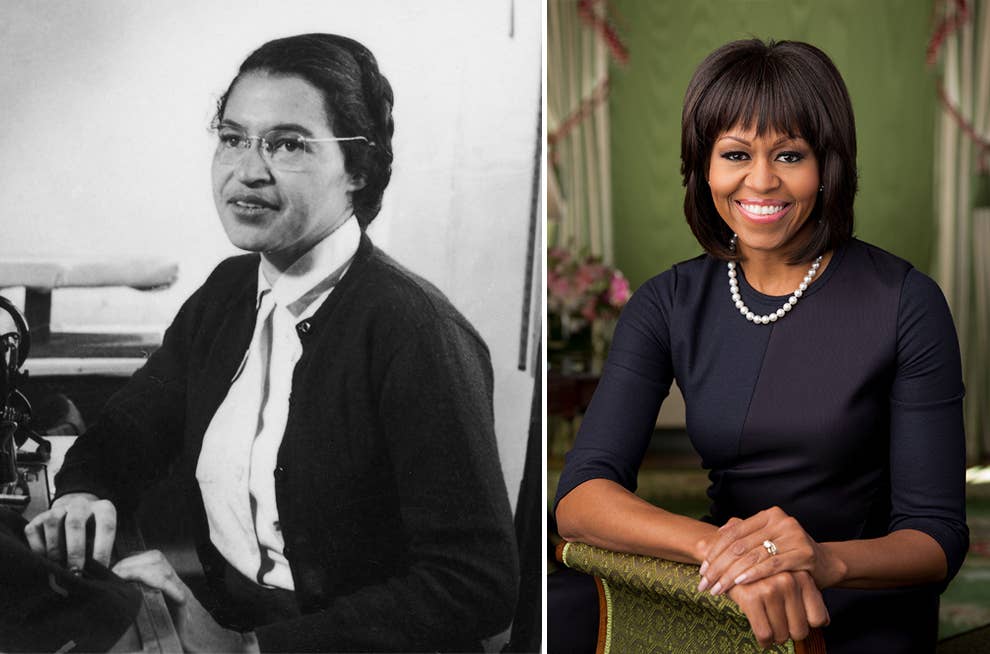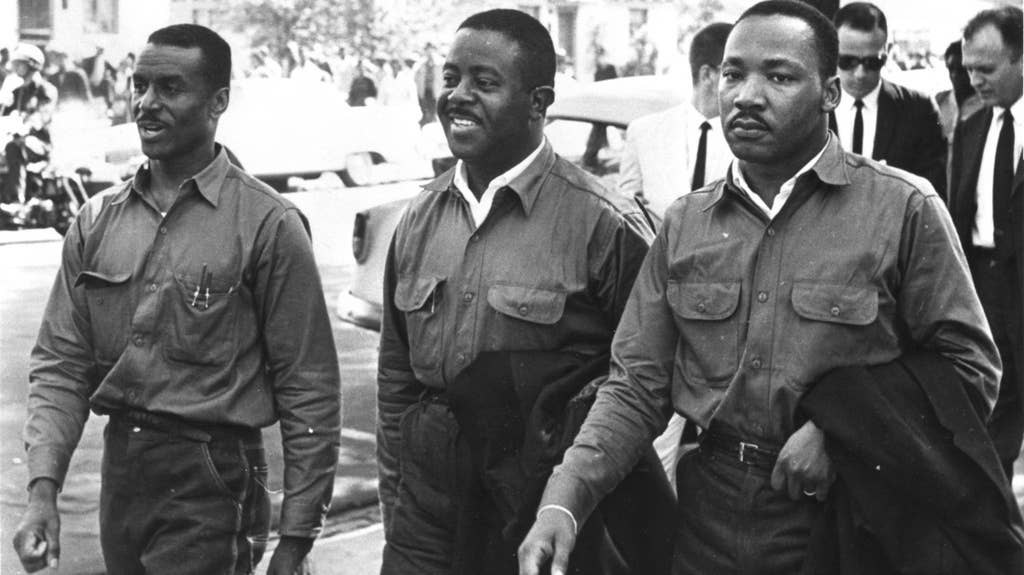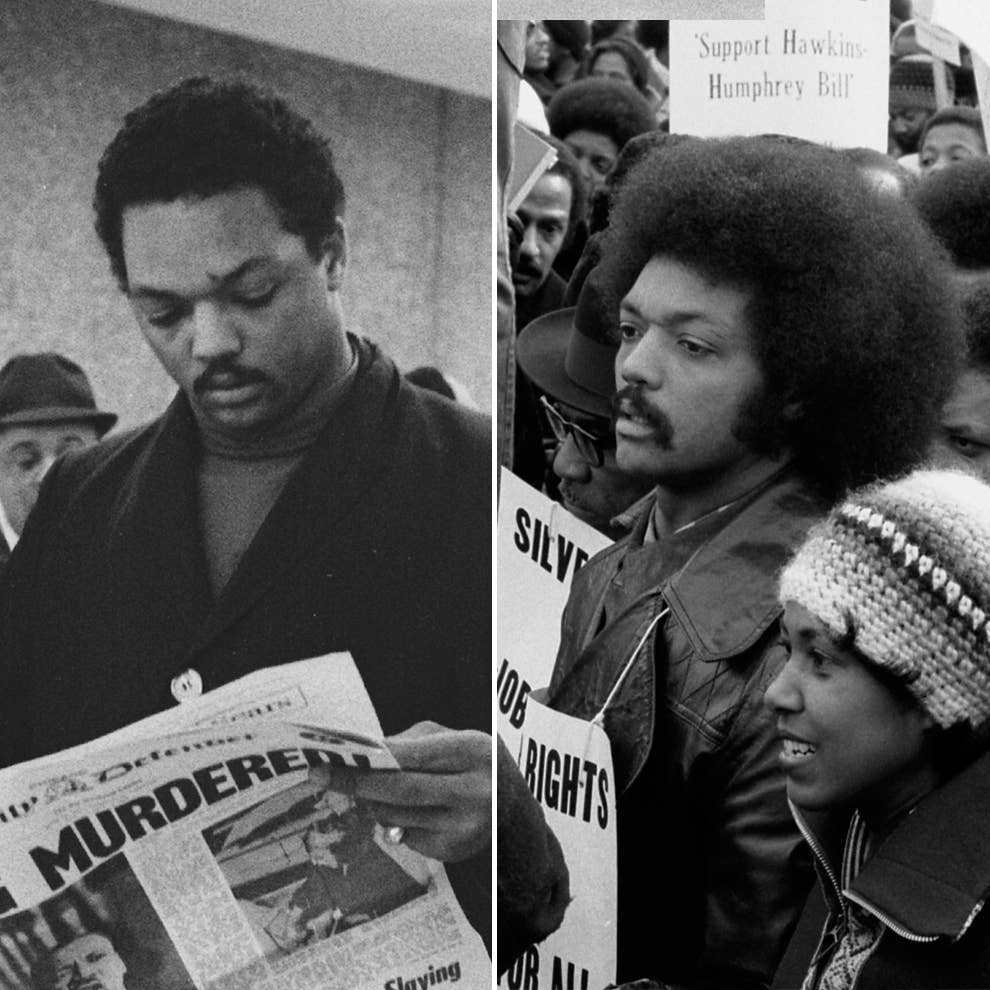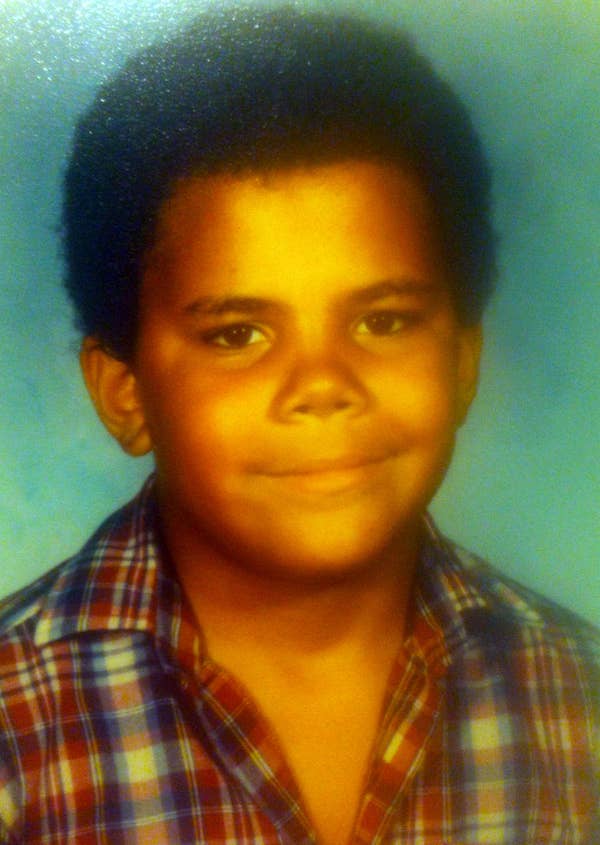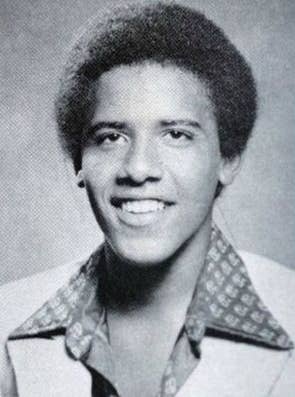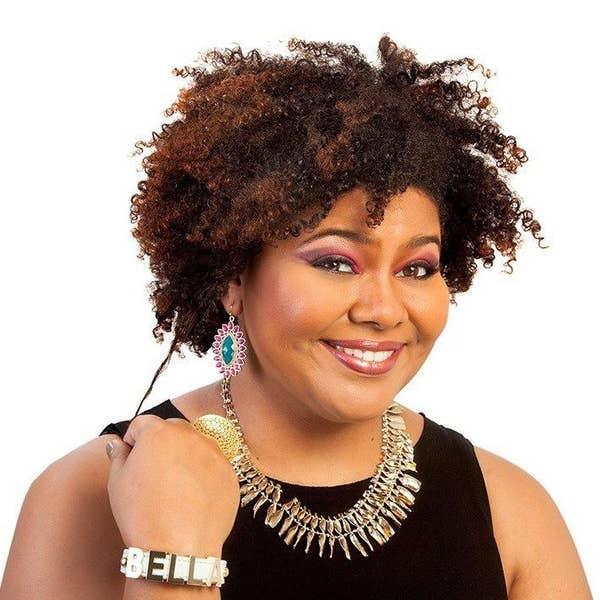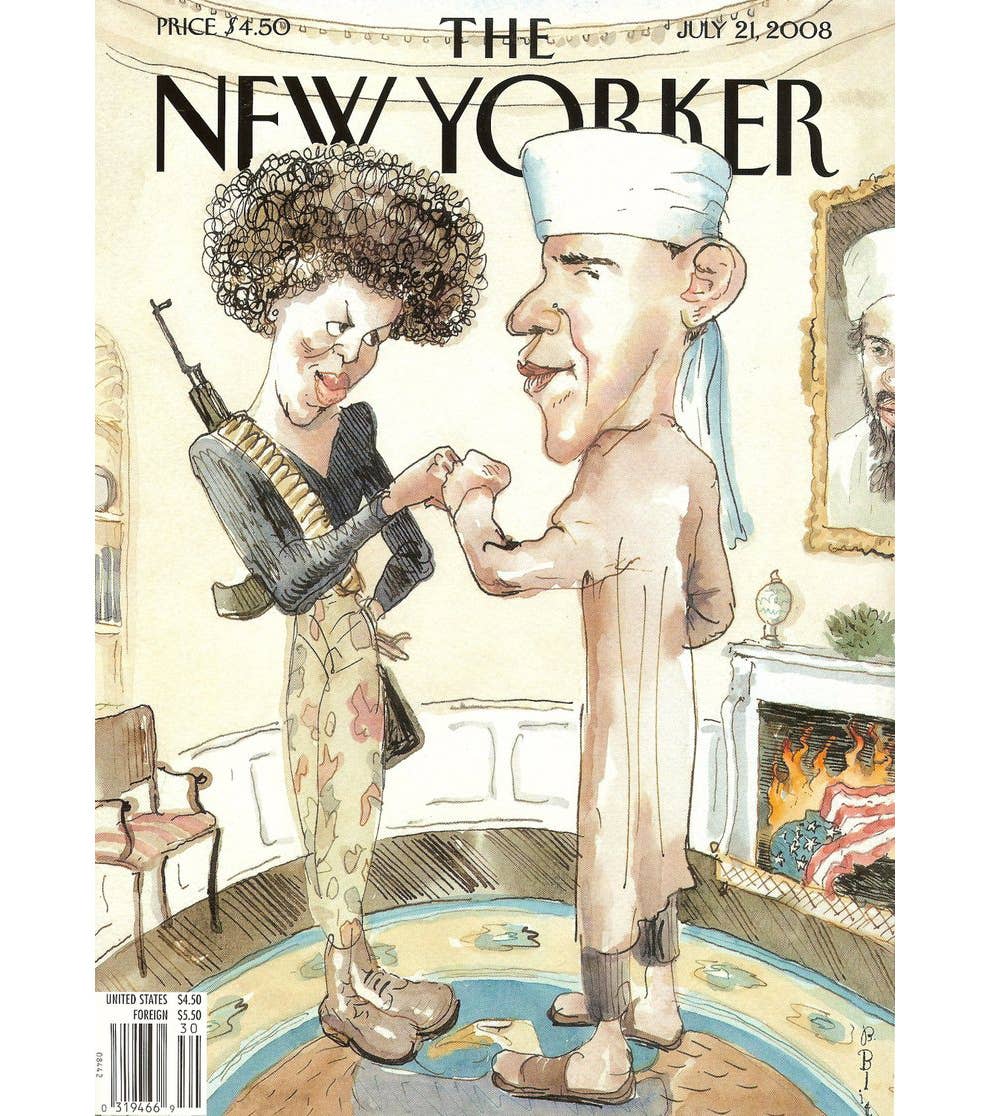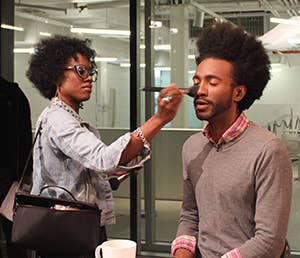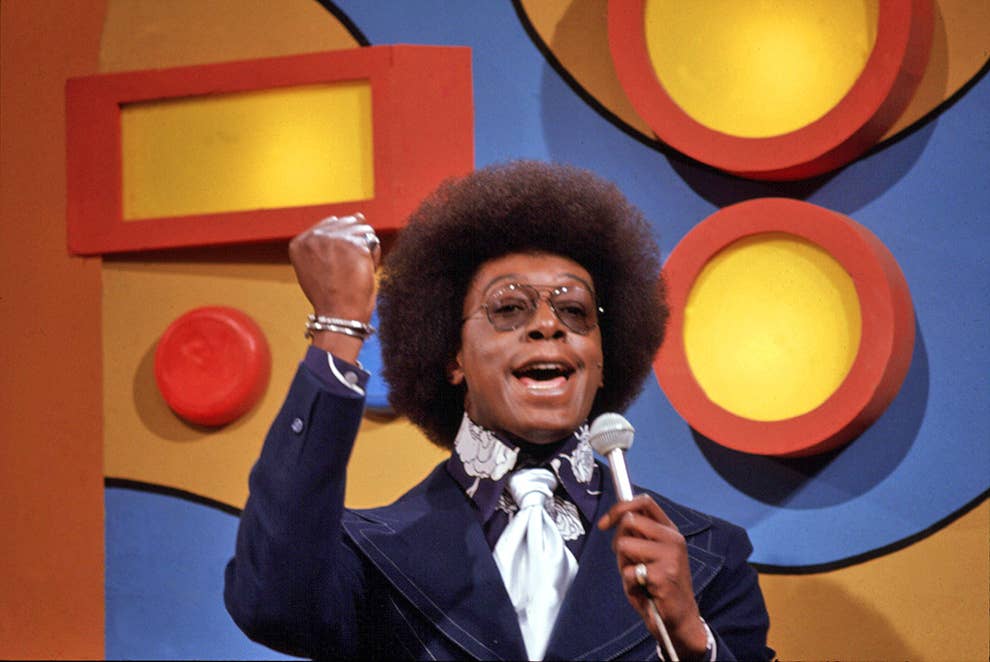RT if you #GoWithTheFro.
Afro Blowout

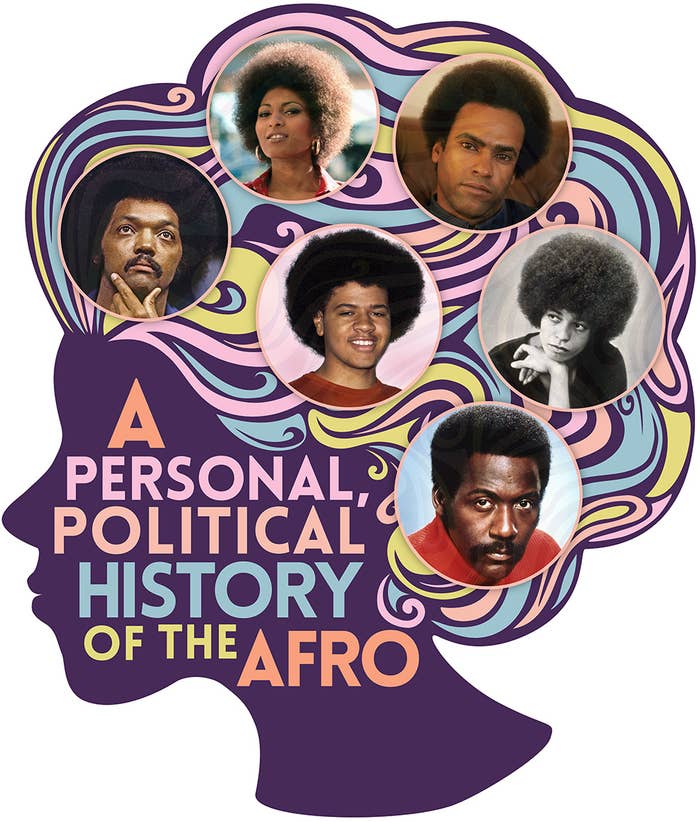
Justine Zwiebel/BuzzFeed, Eduardo Munoz / Reuters (de Blasio), Gallo Images / Rex (Jackson), Everett Collection (Grier), Lee Lockwood/Time Life Pictures / Getty Images (Newton), Hulton Archive / Getty Images (Davis), Everett Collection (Roundtree)
Dante de Blasio’s Afro undoubtedly helped boost interest in the New York mayoral candidacy of his father, Bill de Blasio, on the family’s path to Gracie Mansion. Powerfully, his infamous ad showed New York City voters how the racial-profiling tactics of the NYPD could affect a young man. Dante’s embodiment of this message didn’t register with so many voters (and go viral worldwide) just because he is black, however, but because he is biracial. “The fact that the son became a poster child for stop-and-frisk, which we don’t necessarily associate with biracial bodies, but with black men” was significant, said Noliwe Rooks, a professor of Africana Studies at Cornell University and author of the book Hair Raising: Beauty, Culture and African American Women. Rooks points out that the ad was also an example of how de Blasio’s wife, Chirlane McCray, and their children wear their hair in a way that’s “unselfconsciously black.”

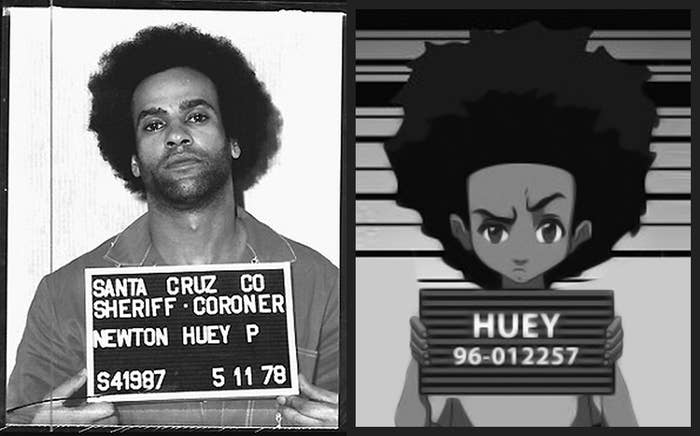
Huey P. Newton, founder of the Black Panthers. His name and hair inspired the character Huey Freeman in The Boondocks. Cartoon Network (The Boondocks)
The New Afro
“A lot of older people like to talk about how they used to have Afros, like in the 70s and 60s, because that was the time when it was really popular,” Dante told DNA Info this summer. His regimen: “[P]ick it out every day and I wash it every week and I get trimmed about once a month.” His mother’s friend, who cuts Dante’s hair, told the site that his Afro was inspired by Huey Freeman onThe Boondocks (who was, in turn, inspired by Huey Newton of the Black Panthers). “His whole family has embraced natural hair, not the Beyoncé look,” Rooks said. “His mother has dreads, the son has an Afro. They are announcing a certain level of comfort with their blackness within this racially blended family.” With dreadlocks, McCray has eschewed the multibillion-dollar weave-and-straightening industrial complex that has both Bey and poor black Americans alike in its grip. It’s a very different dynamic from, say, the Obamas, whom Rooks describes as being “groomed within an inch of their lives.”

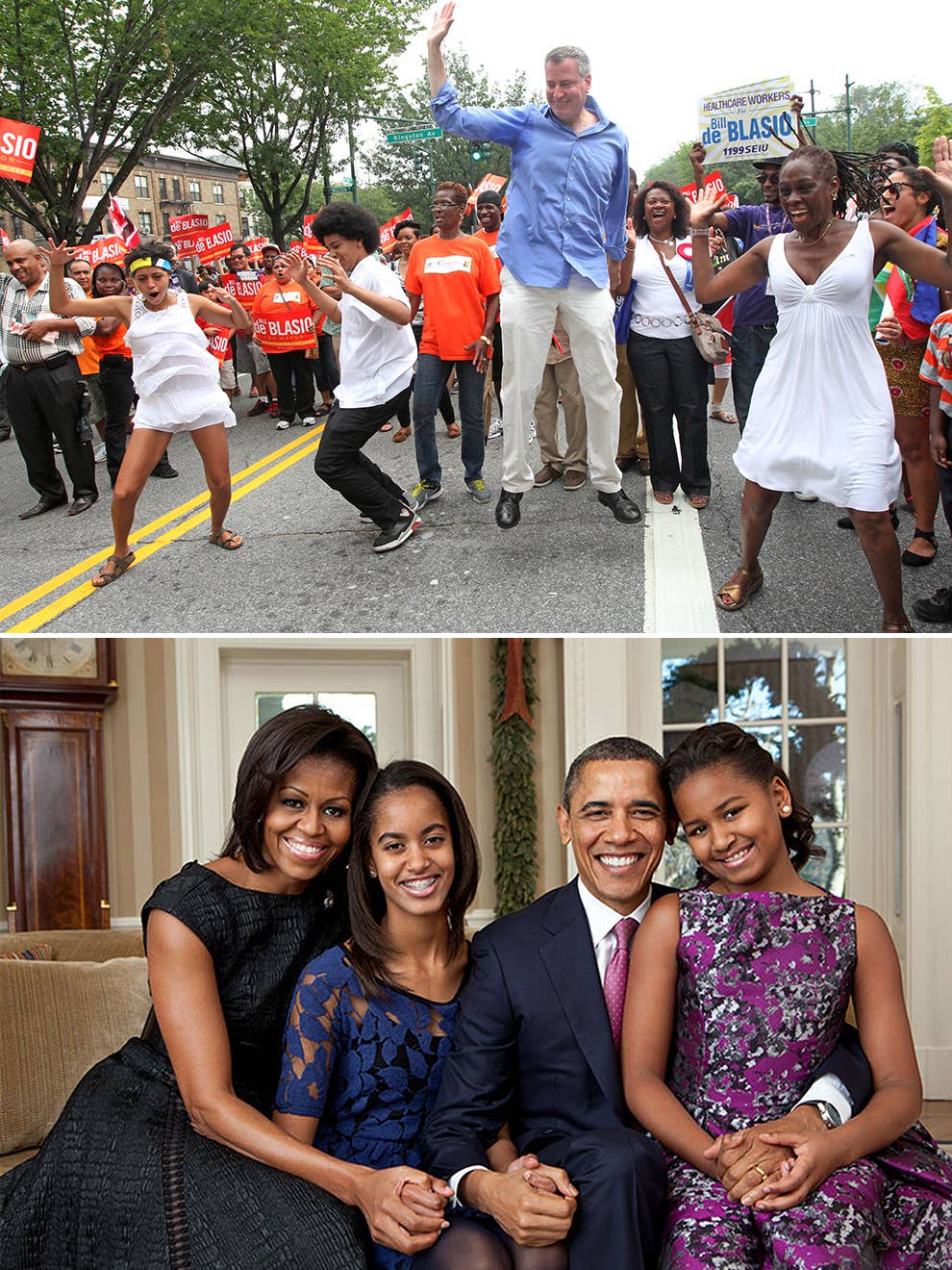
The hair and ethos of the de Blasios is a lil’ different from the Obamas, ya think? Tina Fineberg / AP Photo (de Blasio Family), Official White House Photo by Pete Souza (Obama Family)
Add to this, Rooks said, that voters see the de Blasio kids alongside “their clearly adoring father, who is clearly a white man! He’s clearly a white man! And people see the closeness and the love of this family dynamic.” Political cynics might call it pandering, but de Blasio’s campaign focused in on Dante and stop-and-frisk, connecting white voters to the detriments of the program in a way that had never happened before. And inadvertently, Dante’s Afro became a political symbol like the millions before his. As #GoWithTheFro took off on Twitter, Dante became the latest brother to personify the political history of the Afro.
But he may be the first to do so in an advantageous way in terms of electoral politics. Even in 2013, you’re not likely to see the nation’s biracial president, black attorney general, any member of the Congressional Black Caucus, or any member of any of their immediate families publicly wearing Shaft’s hairdo. So for the de Blasio campaign to focus on Dante’s Afro — which has never been considered politically safe to those seeking white or black votes — was a huge risk. DeBlasio’s election was the first big election won in the United States with the aid of an Afro. And it was certainly the first time a white candidate has benefitted from his association with the kind of hairdo that once symbolized Black Power. Though we now commonly refer to Afros as “natural hair,” this is a relatively new way of thinking.
Before the Afro, straight hair was the ‘do for “respectable” black women, as it once again is today. Don Cravens/Time & Life Pictures / Getty, Chuck Kennedy/White House
During the civil rights movement of the 1950s, black women were straightening their hair to sport locks every bit as straight as the first lady’s are today. Churchgoing black men went to the barbershop to get what is called a “Number One” (just like Michelle’s husband). More adventurous brothers chemically straightened or “conked” their hair, like James Brown or Al Sharpton. “Before the 1960s and the 1970s, it was the close crop that was acceptable,” Rooks said. Longer hair wasn’t an Afro: It “was not considered a hairstyle. It was just considered unkempt,” she said. The tightly trimmed head of hair was a tactic, in its own way, as carefully planned as any boycott. King wanted to win over reasonable, middle-class white people, whom he believed to be a majority in the country. And one technique to win their hearts was to look like them and dress like them, mitigating any sense of otherness based on appearance. The controversy of their message was controversy enough. But by the ’60s, young black activists deemed King’s techniques too slow and too accommodating. And just as with white hippies, hair length became a way for black youth to rebel against their elders. The youth-led Student Nonviolent Coordinating Committee and Stokely Carmichael started to strain against the ways of King’s Southern Christian Leadership Conference. In wanting action, they increasingly rejected their predecessors’ strategy of respectability.
Left to Right: Civil Rights icons Fred Shuttleworth, Ralph Abernathy and Martin Luther King all wore a “Number One”. Courtesy of Birmingham Public Library Archives
Out with the Number One, and in with Black Power, the fist, and the Afro.
The Black Power Afro
“The civil rights movement starts to give way to the Black Power movement,” Rooks said, and Black Panthers helped transform the Afro from an “unkempt” head of hair to a hairstyle imbued with political weight. The Panthers, started by Huey Newton and Bobby Seale, espoused black nationalism over integration, preached armed resistance to the nonviolent variety, and proclaimed that the Afro would replace the suppressive crop. Carmichael left SNCC and eventually aligned with the Panthers before changing his name to Kwame Ture (and leaving the United States altogether). His hair changed with his politics. And by 1968, hip (and, increasingly, political) black men and women alike were eschewing the conk and the crop. Jesse Jackson’s fro was already starting to tower above MLK’s while his mentor was still alive. In the years after King’s assassination in Memphis, Jackson’s hair skyrocketed.
Jesses Jackson’s Afro had started to grow out before MLK’s assasination, but increased dramatically after. Robert Abbott Sengstacke / Getty Images, Buyenlarge / Getty Images
In the early 1970s, the Afro was the haircut of black people that white people who wanted to maintain the status quo feared. Thanks to blaxploitation flicks, the Afro had become a cultural symbol of black ass-kicking. Later in the ’70s, increasingly mainstream celebrities like NBA player Julius Erving, comedian Richard Pryor, and a young Michael Jackson wore their Afros proudly. Though their association made it less militant, they wore their hair as a symbol of their black identity in the face of crossover success. At the height of its popularity — before what Rooks called “the backlash of the Jheri curl,” during the Reagan ’80s — wearing an Afro became a way of differentiating young black Americans both from white America and from their parents. The Reagan ’80s is when my own fight with the Afro began.
My friend Scott, who is white, posted this picture of Dante de Blasio on Facebook shortly after Dante’s father won the Democratic primary for mayor, writing, “Do you have any idea how many politician dads would make him cut this? By force if necessary?” For me, it conjured images of a father wrestling his son, pinning him to the ground, and mowing down his humongous fro with shears. But I wasn’t picturing tall, white Bill de Blasio doing this: I imagined my own black dad busting out the shears and cutting off my fro when I was a kid. Like Dante, I’m mixed race, but it was my late father who was black. My dad, William (or Bill), was the grandson of a born slave and the son of a born sharecropper — a member of the first generation of his family to enter high school, let alone graduate from college. “Mr. Thrasher,” as he was widely known, lived up to his ominous-sounding name, first as a drill sergeant in the United States Air Force; then, as a teacher of “Afro-American studies” after going to college at night on the GI Bill; and, finally, as the vice principal in charge of discipline at my high school. He had skin the color of dark chocolate, hands large enough to palm a basketball without trying very hard, and the kind of countenance that made you stand up when he entered a room. Unfortunately, my dad died a year before Illinois State Senator Barack Obama spoke at the Democratic National Convention in 2004. He would not have believed that America’s first black president would be elected right after George W. Bush. But he would have been equally, if not even more, shocked to know that just five years after that historical event, Dante de Blasio’s Afro would turn out to be a political asset in any election — even in New York — and not a potential cause of its loss. On my friend’s Facebook wall, several of us argued back and forth about whether political consultants would have found Dante’s fro an asset or liability for various voting blocs. If I’d have been Bill de Blasio’s political consultant before that stop-and-frisk commercial was shot, I’d have been afraid not just that white people could be turned off by his son’s hair, but also that older black voters would find it off-putting. Especially given that older voters are the most likely to turn out and actually vote, I would have been very hesitant about putting such a large fro on camera. And I’d have been wrong. Dante’s ad helped his dad surge past the need for even a primary runoff, and de Blasio won with more white votes than any other candidate and more black votes than even Bill Thompson, the only black candidate in the race. This was totally counter to my history with my own Afro (back when I had hair). Mr. Thrasher believed I’d have to work twice as hard as white people just to get to the same place, and there was no point in being dismissed for my hair looking what he described as “squeewad.” He wouldn’t have let me out of the house — let alone on TV! — with hair like Dante’s. He’d have taken the belt off his waist and thrashed me with all the force the Thrashers who’d once owned our ancestors thrashed them with to keep me from presenting myself to the world with hair like that. (Note: It’s not that my dad was afraid of political controversy. Like Dante’s father, Mr. Thrasher protested against Reagan’s beloved Contras in Nicaragua. But his hair was rarely more than an inch long, oddly closer to the look of Cliff Huxtable than to the ‘dos of the black political icons he taught about and revered.)
Brooksfilms / MGM
I’m not sure why I was so intent on growing my hair so long when I was a kid. My bald mid-thirties self wishes I’d grown it longer (and made a wig out of it that I could now wear), but I can’t recall why it was that I fought getting my hair cut so often back then. I was usually the only black guy in my classes at school. I often got teased about my hair, and I recall being associated with the black “we ain’t found shit” pick team in the “comb the desert” scene from Spaceballs. I think a part of my kid self wanted to emphasize my black hair to my white peers, who often told me I wasn’t “really black” because, in doing well in school, I was “acting white.” But even though I fought wildly with my dad about how long I could let my hair grow, I remember that two of my older sisters, Catherine and Sharron, graduated from high school in the ’70s and had sported Afros nearly as voluminous as Dante’s in their senior portraits. I asked them recently why they were allowed to grow their hair so long when I was not.
“It was because you were a boy,” Catherine told me. She said she thought our late dad believed a boy with long hair was going to get judged more harshly than a girl, and that our dad had fought with our brother Mark about the length of his hair — but not with girls in the family. Cathy wanted to look like her hero, Angela Davis, which to her, she said, “meant, ‘black is beautiful.’” But looking like Davis could be dangerous. In the fall of 1970, Davis became the third woman ever placed on the FBI’s 10 Most Wanted Fugitive List, for her role in the Marin County, Calif., courtroom kidnappings and killing. When the chase came to New York City, our family friend Bruni had just started sporting an Afro and was stopped by the NYPD. According to Bruni, one of the cops commanded the other to “check her teeth,” to see if she had the same gap as Davis did. When she didn’t, they let her go. But like me, her fro hadn’t made her fear the NYPD as much as it made her fear her own father. When she’d first gotten her Puerto Rican hair cut short as an adult, Bruni’s dad refused to talk to her and instead asked her mother, “Where is my daughter?” (Later, when she went to the family barber to cut it all off, she said, the barber “needed written permission from my father!”)
The Barack Obama Afro
My friend Bruni (right) was mistaken by the NYPD for Angela Davis because of her Afro. Schulz / Keystone / Getty Images (Davis)
When I asked my sister Sharron what it meant to wear a fro as a mixed-race person, she said, “It’s fun knowing you have something white people can’t have.” She also said there was a belief in our dad’s generation that wearing your hair too long “was not something a well-bred Negro would do” — though our family was not especially well-bred. Sharron went to Occidental College in the early 1980s. There were not many black students there then, but it’s family legend how Sharron came home one weekend atwitter, talking about South African apartheid. She’d been fired up by a speech about why Occidental needed to divest its holdings with institutions that supported the apartheid government, and she was imploring our parents to boycott Bank of America. The speech had been given by an Afro-bedecked student named Barry.
After “Barry,” also known as Barack Obama, the 44th president of the United States, endorsed Bill de Blasio in September, he gave a shout-out to “Dante, who has the same hairdo as I had in 1978 … Although I have to confess my Afro was never that good. It was a little imbalanced.” Despite his praise, Obama hasn’t worn his hair that way for decades, of course. His hair has been closely cropped since he’s been in public life, likely in order to look like “a well-bred Negro.” So much so that his soon-to-be running mate Joe Biden described his then-competitor for the Democratic presidential nomination in 2007 as “the first mainstream African-American who is articulate and bright and clean and a nice-looking guy.” Biden crudely said aloud what many white (and black!) Americans were probably thinking. Like my father, Obama knew he couldn’t let his exterior appearances get in the way of actually accomplishing shit, lest he be written off as an Angry Black Man. After the Reagan years — during which the Afro, like much of Black America, was neutered — the Afro regained political power. Obama surely knew by the ’90s that he could not have sported his college-era fro any more than he could have kept lighting up with the Choom Gang if he wanted to have a life in public office. When it comes to a family’s hair politics, running for mayor of New York is obviously very different than running for president of the United States. It’s not like Bill de Blasio is schlepping Chirlane, Dante, and Chiaro around Iowa and New Hampshire the way Michelle, Sasha, and Malia have had to stump. Voters in New York City have a different idea of whom their first family will be than, say, whom voters in rural Virginia want to see living in the White House.
“People who wear Afros have gotten frustrated that, every few years, it’s called a new movement. A lot of people think it’s new, especially outside of New York or a big city,” said Patrice Grell Yursik, the Chicago-based blogger who writes about black hair and is better known as Afrobella. The reality, Yursik said, is that “you can’t say it’s trendy or cool, it’s just a way of life for a lot of us.” “Simon Doonan wrote a piece, tickled by the trend of ‘going back’ to the Afro, and my friends in Brooklyn were like, ‘What is this guy talking about?’” said Yursik. Still, she said that the fact the de Blasios have been embraced, hair and all, shows “a new maturity” in attitudes toward black hair. For Yursik, the political acceptance of the Afro is now at a high, up from its low in 2008, which had “Michelle Obama cover on The New Yorker, in which she was drawn as a cartoon with a big fro. Can you imagine? That’s how far we’ve come.”
The New Yorker cover by Barry Blitt was a satire meant to skewer the rumors swirling during the summer of the 2008 presidential campaign. But very telling is that the way in which Blitt chose to lampoon Michelle as a power threat — a woman whose real-life hair looks more like Martha Stewart’s than Angela Davis’ — was to give her an Afro. The de Blasios have embraced the very hair that even “liberal” New Yorker readers equate with black militancy. “There was a time when it was believed, obviously, that you can’t wear your hair this way if you’re going to be taken seriously, or if you’re going to be seen in a certain light,” Afrobella said. “That hasn’t happened in this campaign. If anything, [Dante’s Afro] has helped.” Like me, Afrobella thinks a lot of issues about black hair are generational, and she admits that wearing her hair naturally was “something I faced resistance to when I was growing up,” largely from her Trinidadian mother. “I didn’t go natural until my graduation, and I relaxed my hair until my wedding. That was the last thing I did for my mom. That was last thing my mom was paying for, so I figured I could do that for her!” she said, laughing. But for some black people, hair matters aren’t totally a generational issue.
Brian Vines, a senior producer at BRIC/Brooklyn Independent Media and co-host of BK Live, has perhaps one of the more identifiable Afros in Brooklyn. But, he said, “I don’t think of my hair as a fro,” which he thinks more of as the shaped globe Don Cornelius wore on Soul Train. “The world has told me that I have an Afro, or shouted, ‘Hey, Afro!’ at me out of moving cars. That’s not my conception of my hair. It’s just my hair, and I love it when black people are like, ‘What do you do to it?’ And I’m like, ‘You are black. This is what your hair looks like.’” Completely unlike me, Vines had no fights with his father about his hair. His dad was born in 1955 and actually lived as a young man in post-segregation Mississippi with dreadlocks. But as a child, Vines “grew up with a Number One” and was obsessed with haircuts. “My father cut my hair, and I would pester him for a week, and I’d gear up for my haircut. When I was in fourth grade, I wrote an essay about what success would mean in my future, and I had an idea that I wanted to be so rich, I could have my own barber to cut my hair anytime I wanted.” But then in college, Vines locked his hair. After he cut his locks off several years ago, he hasn’t cut his hair since. “It’s funny, I just moved to Bed Stuy,” he said, “and these church women with shiny little wigs were pointing at my hair, giggling at my hair. And I was like, ‘Honey! Your hair came out of a bag, and you’re talking about my hair? That’s the hair you would have if you just let it do what it does!’” Vines said Dante’s hair has been treated as “the biggest political haircut since Michelle Obama’s bangs.” But, to journalists like him who have covered Bill de Blasio for years, “to anyone in my generation and younger, it wasn’t a big deal.” All his son’s hair says about his dad, Vines thinks, is that it gives some insight into how Bill de Blasio “runs his house, and he’s letting [Dante] express himself. By all accounts, Dante seems to be a good, healthy young man.” Dante was astute in knowing that — biracial or not, politician dad or not — he’d be considered black for purposes of racial profiling. In fully embracing this reality through his hair, it’s a political act. But wearing a fro as he does also connects him to all the good and fun ways of being black, and to what that shared political history means. “When I see an old black man on the street, and he looks at me and gives me that knowing head nod, like, ‘Yeah, I used to wear my like that,’ it makes me feel so good,” Vines said. “That history of the shared experience between us. Not to be egomaniacal, but I’ve been afforded so many more opportunities that he has, and walked through so many doors because of him, and have been able to go the extra mile because of his generation … and all of that happened in the seven seconds it took to give each other a head nod. And that makes my day.” It’s that same feeling of camaraderie I feel when I look at a young person with a fro or dreads, even though my hair is long gone, and my head is now shaved — and it’s the same happy jealousy Obama has when he looks at Dante and sees a teenager getting away with something even the president of the United States could not.
The Don Cornelius “Afrosheen” Afro
Check out more articles on BuzzFeed.com! Read more: http://buzzfeed.com/steventhrasher/a-personal-and-political-history-of-the-afro
References:
Afro – Wikipedia, the free encyclopedia
[edit]. During the history of slavery in the United States, most black African- Americans styled their …

Pam Grier’s Afro: Let’s Bring It Back – Slate
1 Apr 2013 … How a date with Blaxsploitation queen Pam Grier kindled my nostalgia for the regal, natural, glamorous hairdo. By Simon Doonan. A 1974 …
5 Aug 2013 … Aevin Dugas, from Louisiana holds the Guinness record for the world’s biggest afro hairdo. Her hair measures 4 feet 4 inches (1.32 m) in …
Bill de Blasio’s Son Tells All About His Show-Stealing Afro – Park …
16 Aug 2013 … Dante de Blasio, 15, has spent years cultivating the afro that has catapulted … “It made me not cut his hair evenly all around so he could get a …





